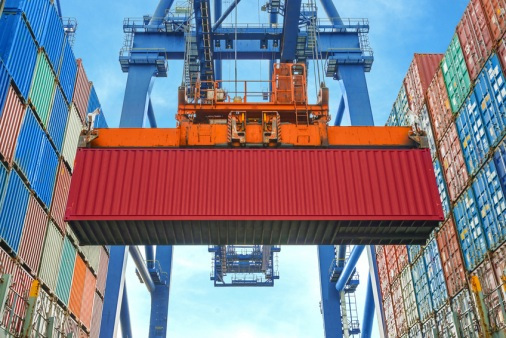Using AI to detect misdeclared cargo

Authored by AXA XL’s Andrew D'Alessio and Allan Ilias
In May 2019, a container ship in a port in Thailand burst into flames. When the fire was extinguished, inspectors expected the damage to be limited to the ship and its cargo. There was a human cost as well, however, with over 130 people being taken to the hospital with eye, throat, and skin irritations. Some of the cargo turned out to be calcium hypochlorite and chlorinated paraffin, none of which had been declared by the shippers.
Some container ship incidents are fatal. In 2018, a container fire claimed the lives of five crew members when sodium dichloroisocyanurate dihydrate, a chlorinating agent, had decomposed. The contents had been misdeclared.
Misdeclaration of container contents was the catalyst for 27 percent of cargo ship incidents in 2016. As recently as 2020, 33 percent of all misdeclarations were willful, either due to high hazardous surcharges or to carrier restrictions/prohibition of products that are in high demand. Proper declaration allows the cargo to be located in an appropriate part of the ship. This limits the impact of temperature variation. It also helps optimize its location on the top or outsides of the container stacks to prevent catastrophic fire spread in the event of ignition.
Of the 5.4 million containers that are declared to be dangerous products each year, 1.3 million could well be poorly packed or incorrectly identified. With over 150,000 volatile containers in the supply chain annually, fire and accidents are of paramount concern for carriers.
Whether to circumvent higher fees and regulations or by accidental omission, misdeclared cargo can be a sizable risk for any cargo operation. Fire is by far the largest risk associated with misdeclared goods. Containers stored over engine rooms or on the top layer are exposed to significantly more heat, which may trigger spontaneous combustion. Vessels do have fire equipment and mitigation processes in place, but those measures may not be enough if containers are not known to be carrying volatile products. Furthermore, fighting fires in the middle of container stacks or below deck is exponentially more difficult. Mitigating this risk is important.
Seeing is believing
The goal is to ensure the shipping contents match the description on the declarations. Screening technologies, such as 2D x-ray scanners and 3D computer tomography, are used to scan containers being loaded onto vessels.
However, scans cannot reveal actual contents in all cases. Some hazardous chemicals appear to be identical in format and packaging to those that are considered safe to transport. A scan cannot determine exactly which chemical is present in the container.
Fortunately, recent advances in technology are making it easier for maritime operators to identify the contents of each container on their vessels. The use of artificial intelligence (AI) allows vessel operators to scan shipping container contents more thoroughly. AI is bringing a new level of transparency and helping to reduce fire hazard risks.
The use of AI in shipping is not new. AI is already helping improve communication throughout the supply chain as well as helping ports with better container tracking, port capacity, and scheduling. Now it is being utilized to detect safety and security issues, such as smuggling, piracy and misdeclared goods.
AI-based screening software scans cargo shipping documentation, flagging potential errors. The software is active, scalable, and reliable; it is comparing millions of declarations, origins, shipping, lines, various logistics data points versus each shipment to detect abnormalities.
For example, those containers said to be carrying calcium chloride, a harmless chemical, that are actually carrying calcium hypochlorite, a volatile chemical that is unstable under certain conditions. AI could have alerted operators to possibly problematic variances, past shipments of the shipper or consignee, including incomplete documentation, a misspelled shipping company name, missing or false codes, and last-minute booking changes.
Once a potentially misdeclared container is identified, inspectors can make a determination before the container is ever loaded onto the ship. Likewise, some AI scanning technologies will focus on properly declared cargo as a check and balance. AI draws on data, documentation, and even information from declared cargo to measure each container booking against those criteria to identify potential problems. It can even review what is declared versus the actual container weight. It can also review what the weight should be or has been for other similar shipments in attempts to find red flags.
Safer sailing
Such AI-driven technology can boost safety by indicating possible issues before containers are loaded onto ships. With an increased level of comfort that another layer of checking against misdeclared cargo is operating autonomously, vessel operators will be more efficient during load and discharge. In the long run, the supply chain is hardened against accidents.
With more scrutiny and oversight placed on the contents of each container, shippers looking to avoid hazardous contents fees or even those smuggling contraband are being sent the message – vessel operators are now able to detect more accurately what is being transported.
Over time individual shipper’s benefit with safer and in turn, faster shipping durations. AXA XL marine is actively working to support various Insurtech initiatives as technology develops. Contact a local representative to learn more.
About AXA XL
AXA XL is the P&C and specialty risk division of AXA which provides property, casualty, professional and speciality products to industrial, commercial and professional firms, insurance companies and other enterprises, here in the UK and throughout the world. With underwriting teams based in the US, UK, EMEA and Asia Pacific regions, we can make decisions close to the markets you serve and work with you to tailor cover to your business needs.
We help businesses adapt and thrive amidst change. Rather than just paying covered claims when things go wrong, we go beyond protection into prevention so your business can go beyond the unexpected.

